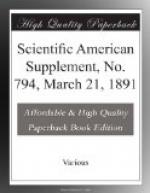The matter of brakes is coming up for more attention in these days of high speed, heavy cars and crowded roads, and the total available braking power, which has hitherto been but partially taken advantage of, must be fully utilized. I refer to the fact that many of our wheels in six-wheel trucks have gone unbraked where they should not. As the height of cars and length of trucks cannot well be increased for obvious reasons, it is necessary to keep the size of the wheels within the limits that will enable us to get efficient brakes on all of them that carry any weight. This is not easy with a 42 in. wheel in a six-wheel truck, which is usually the kind that requires most adjustment and repairs after long runs. The Pullman Co. has recognized this fact, and is now replacing its 42 in. wheel with one 38 in. in diameter.
A 42 in. wheel with 4 in. journal has a greater leverage wherewith to overcome the resistance of journal friction than the 38 in. wheel with the same journal, and even more than the 36 in. and 33 in. wheels with 33/4 in. and 31/2 in. journals respectively, but the fact remains that the same amount of work has to be done in overcoming the friction in each case, and what may be gained in ease of starting with the large wheel is lost in time necessary to do it, and in the extra weight put into motion.
A large wheel increases the liability to bent axles in curving on account of greater leverage unless the size and weight of the axle are increased to correspond, and the wheel itself must be made stronger. A four or six wheel truck will not retain its squareness and dependent good riding qualities so well with 42 in. wheels as with 33 in. ones. Besides the brakes, the pipes for air and steam under the cars interfere with large wheels, and as a consequence of all this 42 in. wheels have been replaced by 36 in. ones to some extent in some places with satisfactory results. On one road in particular so strong is the inclination away from large wheels that 30 in. is advocated as the proper size for passenger cars.
On the other hand, there is no doubt a car wheel may be too small, for the tires of small wheels probably do not get as much working up under the rolls, and therefore are not as tough or homogeneous. Small wheels are more destructive to frogs and rail joints. They revolve faster at a given speed, and when below a certain size increase the liability to hot journals if carrying the weight they can bear without detriment to the rest of the wheel. Speed alone I am not willing to admit is the most prolific source of hot boxes. The weight per square inch upon the bearing is a very important factor. I have found by careful examination of a great many cars that the number of hot boxes bears a close relation to the weight per square inch on the journal and the character of lubrication, and is not so much affected by the size of wheel or speed. These observations were made upon 42 in., 36 in. and 33 in. wheels in the same trains. We find, furthermore, that while a 3-3/8 in. journal on a 33 in. wheel is apt to heat under our passenger coaches, a 33/4 in., even when worn 3-5/8 in., journal on a 36 in. wheel runs uniformly cool. In 1890 on one division there were about 180 hot boxes with the small wheel, against 29 with the larger one, with a preponderance of the latter size in service and cars of the same weight over them.




